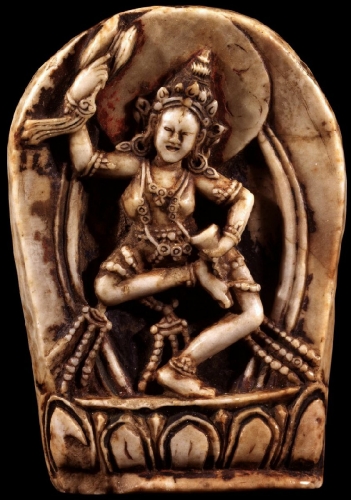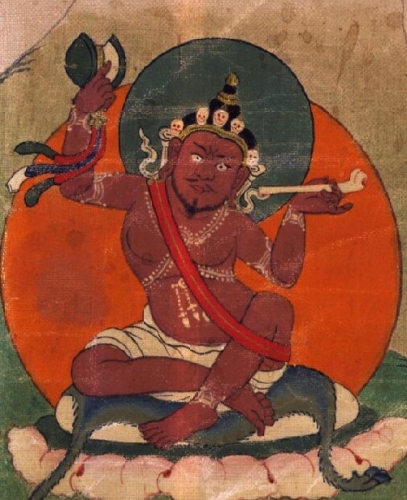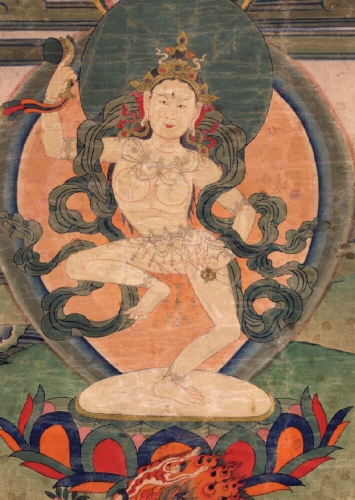Biography and autobiography in Tibet are important sources for both education and inspiration. Tibetans have kept such meticulous records of their teachers that thousands of names are known and discussed in a wide range of biographical material. All these names, all these lives—it can be a little overwhelming. The authors involved in the Treasury of Lives are currently mining the primary sources to provide English-language biographies of every known religious teacher from Tibet and the Himalaya, all of which are organized for easy searching and browsing. Every Tuesday on the Tricycle blog, we will highlight and reflect on important, interesting, eccentric, surprising and beautiful stories found within this rich literary tradition.
Treasury of Lives: Machik Labdron

Machik Labdron (1055-1149) was one of the few Tibetan women to attain a high religious status and establish a teaching tradition. She is revered in Tibet as the progenitor of Chöd—an ego-cutting practice wildly popular among laypeople and monastics alike. Though it has Indian antecedents, Chöd is a Tibetan innovation. Numerous legends attempt to legitimate the practice as an Indian import while still venerating Machik as its creator. This is primarily achieved by claiming that she was the rebirth of an Indian tantrika who was told by the gods that he would be reborn in Tibet in order to propagate the teachings.
Machik Labdron was born in Labchi, in southern Tibet. When she was a child she was invited to a festival by the ruler of the region, to whom she recited a Prajnaparamita sutra. Greatly impressed with her, he gave her the name Labdron—the Shining Light of Labchi.

After studying with several Tibetan teachers, including the Nyingma lama Drapa Ngonshe (1012-1090), Machik is said to have met the Indian Pandita Padampa Sanggye (d. 1117?), who, some sources claim, came to Tibet looking for the rebirth of Machik’s previous incarnation. Padampa Sanggye is remembered for bringing the Zhije teachings to Tibet, which are closely related to Chöd. Some sources hold him to be the primary teacher of Machik and thus the source of the Chöd tradition, whereas others claim that Machik only gazed upon Padampa Sanggye from afar and never actually met him. In any case, soon after the alleged or actual meeting with Padampa Sanggye, Machik began to dress in rags, hang out with lepers, sleep anywhere, and eat anything, essentially adopting the lifestyle of an Indian tantrika.
At the age of 20 Machik received teachings and initiations from Kyoton Sonam Lama along with several other yogis. Tradition holds that during the initiations her body rose one cubit above the ground, floated through the walls, and landed at the Tree of Serlak—a place feared for its large population of snake demons. The bodhisattva Tara then appeared to her in a vision, giving her a number of initiations and predicting that her teachings would spread widely.

Soon after, possibly at the recommendation of her teachers, Machik Labdron met an Indian practitioner named Topa Bhadra, with whom she had several children over the course of the next decade. She then returned to her life as a wandering renunciate and began giving initiations to people she met along the way. She attracted disciples from across Tibet, with word eventually spreading to India of a powerful female teacher who had established a religious tradition called Chöd.
Legend has it that three Indian panditas travelled to Tibet to check her out. To prove herself, Machik gave a teaching in front of a large audience in which she described her previous life in India. She spoke of the body of her previous incarnation, revealing that it still lay perfectly preserved in a cave in India. Machik told the Indians that if they cremated the corpse, a number of auspicious signs would manifest, including a sweet smell, rainbow light, and a number of auspicious symbols on the bones. They accordingly found the body and revealed the auspicious signs. This story illustrates how Machik was conceived as both Tibetan and Indian, authenticating Chöd’s Indian origin and allowing it to be credited as a Tibetan creation at the same time.
Among Machik’s closest disciples was her youngest son Tonnyon, “crazy son of Tonpa,” who was regarded as insane until being cured after she sent him to sleep among corpses at a charnel ground. Machik passed away at the age of 99.
Thank you for subscribing to Tricycle! As a nonprofit, we depend on readers like you to keep Buddhist teachings and practices widely available.